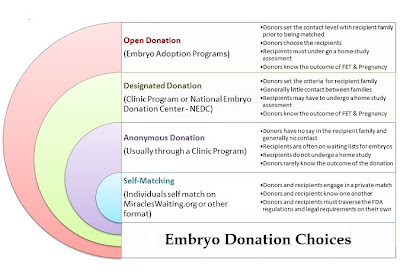Individuals and Couples hoping to build their families through embryo donation and adoption have options available to them. Below are a list of choices families can make.
Self-Matching: Some families are able to self-match on private embryo matching sites, or simply by receiving embryos from someone they know. When choosing this option, it is important to contact a third-party reproductive rights attorney to assist you in forming legal contracts with the genetic family. It may also take some work to ensure that the Food and Drug Administration’s (FDA) requirements are met.
Anonymous Donation: Many Fertility Clinics have in house embryo donation programs. Some of these programs are open to outside patients, but are often only for current patients. The majority of clinic programs offer only anonymous donation, and many have a waiting list to receive embryos.
Designated Donation: Designated Donation, which allows the donors to have a say in who receives their embryos, is available through a few fertility clinic programs and the National Embryo Donation Center (NEDC). Designated donation allows the donor to set the criteria regarding the make-up of the embryo recipients. Criteria often include recipient religion, age, education level, etc. All recipients at the NEDC are required to undergo a home study assessment, helping to prepare the recipient for life with a child not genetically related to them. Many designated donation programs do not facilitate on-going contact. Embryo donors are generally told about the result of the thaw and Frozen Embryo Transfer Procedure (FET) and if a baby was born.
Open Donation: Open embryo donation is the model followed by most Embryo Adoption Programs around the U.S. These programs apply the best practices of adoption to embryo donation. They all require a home study assessment for all recipient families and allow the genetic and recipient families to mutually agree upon the level of contact they wish to have moving forward. Donor and recipient families are matched based on a number of different criteria they supply to the embryo adoption program. Typically they involve on-going contact in some form after the adoption. Contact levels vary from an agency acting as the liaison between families, or direct contact ranging from yearly email updates to in person visits if desired. Embryo donors are always told about the result of the thaw, the FET and if a baby was born.
To learn more about embryo donation and adoption, and all of your options please visit the Awareness Center website at EmbryoAdoption.org.
(Please read comment policy before commenting)


Recent Comments